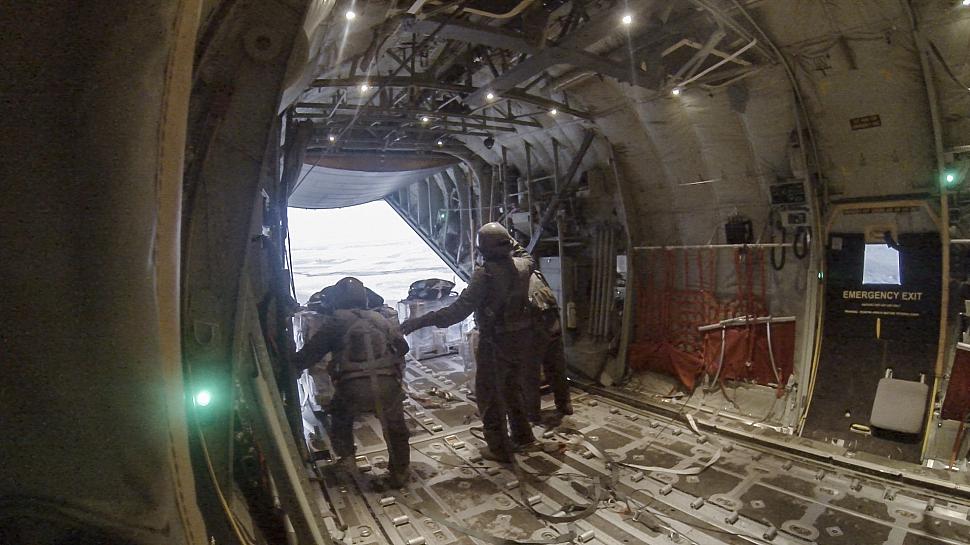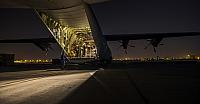C-130 News
C-130 Hercules News
US Air Force helps Iraq develop airdrop capability
December 10, 2014 (by
TSgt. Jared Marquis) -
For the last several months, members of the 386th Air Expeditionary Wing have worked with Iraqi forces to help develop and refine Iraq’s airdrop capability.

The initial effort was a success as Iraqi air forces successfully dropped five bundles of food to the citizens of Amirli, Iraq, Aug. 20, 2014. Since then, 386th AEW personnel have continued to help in an advisory role to share their experience and improve the process.
As a result of that partnership, C-130s from Iraq were able to drop 153 bundles containing 168,300 pounds of humanitarian aid near Sinjar, Iraq, between Nov. 10-24.
The airdrops are an important way for Iraq to get food, medicine and other necessities to the people who may not have access to it, as well as resupply their own troops, said Lt. Col. Greg Young, 386th Expeditionary Operations Support Squadron commander.
“Many of the areas that need to be resupplied by the Iraqi air force … have been cut off from major lines of communication,” he said. “That’s what led us to help bolster the capability they already had.”
A number of factors go in to planning an airdrop, said Young. They include pre-mission planning, selecting the drop zone, selecting the altitudes for the drop, safety concerns for aircrew, cargo and people on the ground, as well as loading the aircraft and actual mission execution.
While many of the Iraqi aircrews had previously received training on airdrops at Little Rock Air Force Base, Ark., they did not have any real-world experience.
“What we hoped to accomplish with the Iraqi forces during our time in Iraq was to be able to take the capability they had already received through their training in the United States and to be able to execute their mission effectively and safely,” he said.
In addition to helping the pilots, 386th AEW personnel also assisted the Iraqi riggers and loadmasters.
Behind the scenes, a lot of the work that was done to help this program take flight was to find what the Iraqi air forces capabilities currently were, assess their goals, and help them develop a plan to meet those goals, said Master Sgt. Justin Speight, 737th Expeditionary Airlift Squadron loadmaster superintendent.
While 386th AEW personnel have assisted and advised the Iraqi aircrews, the mission and capability is still their own.
The goal of this continuing effort is to enable the Iraqi air force to conduct missions in their own way, allowing them to determine their own processes and measures of success and effectiveness, said Young.
“U.S. support enables the Iraqi’s mission in a number of ways,” he said. “We provide mentorship for their forces and we provide confidence for their leadership that the mission can go as planned.”
The real impact of this partnership and what the Iraqi’s have accomplished is that a child who might not have been eating on a regular basis has fresh food and water, said Young.

Loadmasters from the Iraqi air force release bundles of food and water from the back of an Iraqi C-130J Super Hercules on August 30, 2014. The Iraqi air force dropped five bundles of food and water to citizens in Amirli, Iraq after working alongside pilots and loadmasters from the United States Air Force’s 737th EAS. This mission was the first successful humanitarian aid airdrop conducted solely by the Iraqi air force. [USAF photo by SSgt. Jeremy Bowcock]
As a result of that partnership, C-130s from Iraq were able to drop 153 bundles containing 168,300 pounds of humanitarian aid near Sinjar, Iraq, between Nov. 10-24.
The airdrops are an important way for Iraq to get food, medicine and other necessities to the people who may not have access to it, as well as resupply their own troops, said Lt. Col. Greg Young, 386th Expeditionary Operations Support Squadron commander.
“Many of the areas that need to be resupplied by the Iraqi air force … have been cut off from major lines of communication,” he said. “That’s what led us to help bolster the capability they already had.”
A number of factors go in to planning an airdrop, said Young. They include pre-mission planning, selecting the drop zone, selecting the altitudes for the drop, safety concerns for aircrew, cargo and people on the ground, as well as loading the aircraft and actual mission execution.
While many of the Iraqi aircrews had previously received training on airdrops at Little Rock Air Force Base, Ark., they did not have any real-world experience.
“What we hoped to accomplish with the Iraqi forces during our time in Iraq was to be able to take the capability they had already received through their training in the United States and to be able to execute their mission effectively and safely,” he said.
In addition to helping the pilots, 386th AEW personnel also assisted the Iraqi riggers and loadmasters.
Behind the scenes, a lot of the work that was done to help this program take flight was to find what the Iraqi air forces capabilities currently were, assess their goals, and help them develop a plan to meet those goals, said Master Sgt. Justin Speight, 737th Expeditionary Airlift Squadron loadmaster superintendent.
While 386th AEW personnel have assisted and advised the Iraqi aircrews, the mission and capability is still their own.
The goal of this continuing effort is to enable the Iraqi air force to conduct missions in their own way, allowing them to determine their own processes and measures of success and effectiveness, said Young.
“U.S. support enables the Iraqi’s mission in a number of ways,” he said. “We provide mentorship for their forces and we provide confidence for their leadership that the mission can go as planned.”
The real impact of this partnership and what the Iraqi’s have accomplished is that a child who might not have been eating on a regular basis has fresh food and water, said Young.
Courtesy of 386th Air Expeditionary Wing
Related articles:
Forum discussion:
Tags
- $800 million sustainment deal for Iraq's fleet of C-130s (2014-11-26)
- Iraq to take delivery of final three C-130Js (2013-04-29)
- C-130 Fighting Falcon news archive
Forum discussion:
- Start a discussion about this article in the C-130.net forum.
Tags
Additional images:

Members of the Iraqi air force load pallets of food and water onto an Iraqi C-130J Super Hercules on August 29, 2014 in Baghdad, Iraq. After working alongside the United States Air Force during a military to military engagement, the Iraqi air force successfully dropped five bundles delivering food and water to citizens in Amirli, Iraq August 30, 2014. [USAF photo by SSgt. Jeremy Bowcock]
